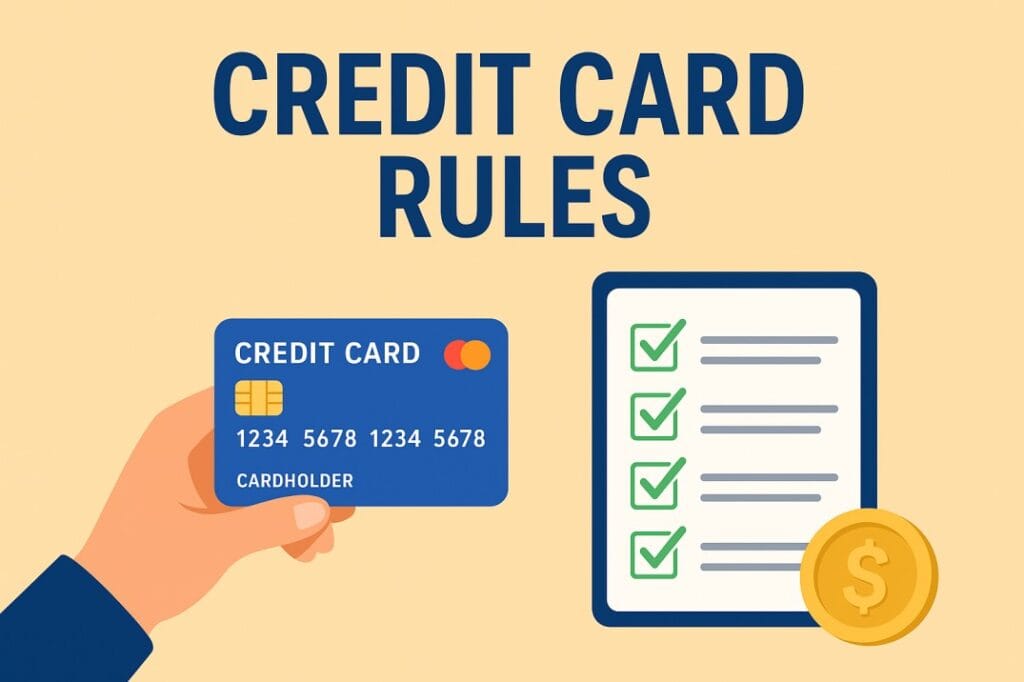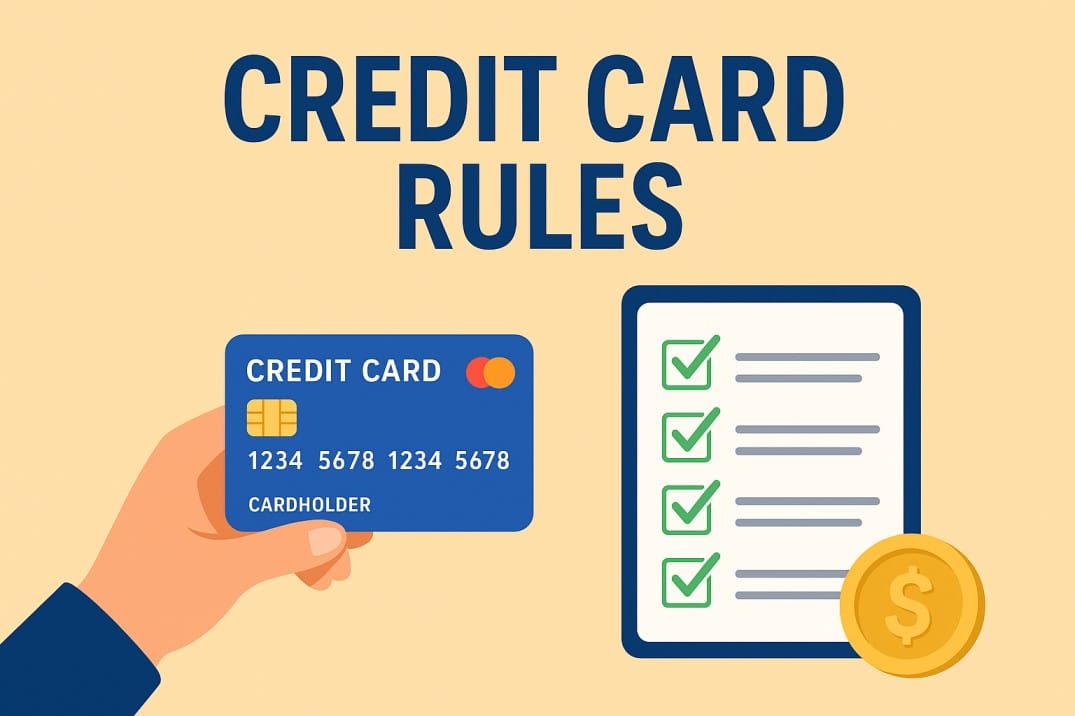Introduction

Aaj kal credit card plastic payments common hain. Lekin agar rules follow nahi kiye to fees, interest, aur fraud ka risk badh jata hai. Is article mein main aapko clear, actionable aur easy-to-follow rules doonga jise follow karke aap paise bacha sakte ho aur credit history strong bana sakte ho.
2. Basic rules — pehle samajh lo
- Time par payment karo — due date kab hai wo dekhna bahut zaroori hai.
- Full payment karna best hota hai — agar possible ho to statement balance poora chuka do.
- Minimum payment sirf emergency ke liye — baar-baar minimum dena costly padta hai.
- Budget set karo — monthly spending ka limit decide karo.
- Statement check karo — har mahine ke statement ko review karo for errors or fraud.
3. Step-by-step: Card lene se pehle kya check karein
Step 1: Annual fee aur joining offers check karo.
2: Interest rate (APR) aur billing cycle samjho.
3: Reward program aur cash back dekh lo — kya aapko benefit milega?
4: Credit limit kitna hai — realistic limit lena accha hota hai.
5: Customer service aur dispute process padho.
Example: Agar ek card ka annual fee ₹1,000 hai par 5% cash back grocery pe milta hai, aur aap monthly ₹10,000 grocery kharch karte ho to annually cash back = 10,000 × 12 × 5% = ₹6,000. Is hisab se fee justify ho sakti hai.
4. Billing cycle aur due date ka funda
- Billing cycle: Ye woh period hai jisme transactions collect hote hain (usually 25–31 din).
- Statement date: Iss din aapka statement generate hota hai.
- Due date: Iss date tak payment karni hoti hai.
Tip: Statement date aur due date ko calendar mein mark karo. Agar aap salary receive karte ho har mahine ki 1st ko, to due date ko match karo taaki cashflow smooth rahe.
5. Interest samajhna (simple math example)
Agar aap full payment nahi karte to interest lagta hai. Simple example:
Balance = ₹10,000
Monthly interest rate = 3%
Calculation (digit by digit):
- 10,000 × 3 = 30,000
- 30,000 ÷ 100 = 300
To monthly interest = ₹300. Agar aap sirf minimum pay karte ho, to principal kam dheere hoga aur cumulative interest zyada banega.
6. Credit utilization aur score par effect
Credit utilization = (Outstanding balance ÷ Credit limit) × 100
Example: Limit = ₹50,000, Balance = ₹25,000
Calculation: 25,000 ÷ 50,000 = 0.5 → 0.5 × 100 = 50%
Rule of thumb: Utilization ko 30% se neeche rakhne ki koshish karo. Low utilization aapke score ko help karta hai.
7. Payments: best practices (stepwise)
Step A: Har mahine statement aate hi poora balance check karo.
B: Agar possible ho to full payment do.
C: Agar full possible na ho, to more than minimum pay karo.
D: Auto-pay set karo for at least minimum amount.
E: Extra payment karne par interest jaldi kam hoga.
Example: Agar minimum ₹1,000 aur aap ₹3,000 pay karte ho to remaining balance jaldi kam hota hai aur interest bhi kam lagega.
8. Fees — kin cheezon se bachna hai
- Late payment fee — due date miss karne par lagta hai.
- Overlimit fee — limit se zyada kharch karne par.
- Cash withdrawal fee — ATM se cash nikalna mehenga padta hai.
- Foreign transaction fee — international purchases par percentage charge.
- Penalty APR — repeated missed payments par interest rate increase ho sakta hai.
Tip: Cash withdrawal avoid karo; agar zaroorat ho to planning se karo.
9. Rewards aur redemption tips
- Jo card aap le rahe ho, uske rewards category dekho (groceries, fuel, travel).
- Points jab expire hote hain to note karo.
- Redemption options: statement credit, vouchers, flight booking, gift cards.
- High-value redemption ko target karo — points ko direct cash ka best value milna chahiye.
10. Security & fraud prevention (must-follow)
- PIN kisi ko nahi batao.
- OTP confidential rakho.
- Card details sirf trusted websites par use karo (https).
- Transaction alerts enable karo.
- Agar card lost ho jaye to turant bank ko block karwa do.
- EMV chip aur contactless payments secure hain — magar small transactions par bhi check karo.
Example fraud scenario: Aapko unknown ₹500 ka SMS aata hai. Turant check karo: agar transaction aapki nahi to bank ko call karke dispute file karo.
11. Common mistakes to avoid
- Impulse buying — discount dekh ke unnecessary kharidna.
- Only paying minimum — interest trap.
- Ignoring statements — unauthorized charges miss ho sakte hain.
- Multiple cards unmanaged — due dates confuse ho sakte hain.
- Closing old cards without considering credit history effect.
12. How to build strong credit history (practical steps)
- Regularly on-time payments karo.
- Credit utilization maintain karo (≤30%).
- Purane accounts ko unnecessarily close mat karo.
- Mix of credit card (one card, one small loan) agar possible ho.
- Agar new ho to secured card consider karo.
13. Advanced tips: balance transfer, EMI, and offers
- Balance transfer: High-interest balance ko lower-rate card par transfer karna. Check transfer fees.
- EMI conversion: Large purchases ko EMI mein convert karte waqt processing fee aur effective rate dekho.
- Introductory offers: 0% APR for few months — plan karo repayment before offer ends.
14. Disputes and chargebacks — kya karein agar problem ho
- Statement se error note karo.
- Bank ke helpline par call karo aur transaction dispute file karo.
- Written complaint aur evidence (receipts, emails) save karo.
- Agar bank se solution nahi milta to regulator (e.g., ombudsman) ko approach karo.
15. Real-life example: Smart monthly plan (Credit Card)
Situation: Monthly salary ₹40,000. Aap grocery, bills aur fuel cover karte ho.
Step 1: Budget category set karo — groceries ₹8,000; bills ₹6,000; fuel ₹4,000; savings ₹10,000; other ₹12,000.
2: Card choose karo with 3% cashback on groceries.
3: Pay full monthly statement. Agar total card spend ₹18,000 and cashback 3% on ₹8,000 groceries = 8,000 × 3 ÷ 100 = ₹240.
Step 4: Use remaining savings to build emergency fund.
Is plan se aap rewards earn karte ho aur interest nahi dete.
16. Frequently asked questions (short & clear)
Q: Minimum payment kab karein?
A: Due date se pehle. Agar full possible na ho to kam se kam minimum se zyada do.
Q: Kitne cards rakhne chahiye?
A: Quality over quantity. 1–3 cards manageable rahte hain.
Q: Balance transfer kab useful hai?
A: Jab existing balance high-interest pe ho aur transfer fee total cost se kam ho.
17. Quick checklist — printable (Credit Card)
- Statement date note kiya?
- Auto-pay set kiya?
- Emergency fund ready?
- Fraud alerts on?
- Utilization ≤30%?
- Full payment try kiya?
18. Common myths — sach kya hai
Myth: Credit card debt se hi credit score kharab hota hai.
Sach: Agar payments on time aur utilization low ho to card credit score improve karta hai. Debt kharab tab hota hai jab interest aur missed payments ho.
Myth: Multiple cards hamesha risky hote hain.
Sach: Agar aap number manage kar sakte ho to multiple cards rewards diversify karne mein help karte hain.
19. Final actionable routine (daily/weekly/monthly)
Daily: Transaction alerts check karo.
Weekly: Recent spends review karo.
Monthly: Statement reconcile karo aur payment schedule set karo.
Quarterly: Reward redemption aur offers review karo.
Conclusion
Agar aap in rules ko follow karenge to financial stress kam hoga, aap rewards maximize kar paoge aur credit history strong banegi. Simple cheezen — on-time payment, low utilization, aur statement review — aapki long-term financial health ke liye sabse important hain. Ab aapke paas ek step-by-step plan aur real examples hai — shuru kijiye, disciplined rahiye, aur agar koi specific situation ho to batao — main further examples aur templates bhi de dunga.

